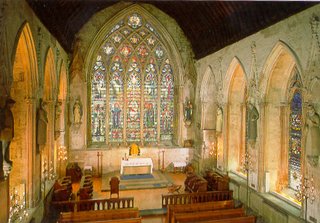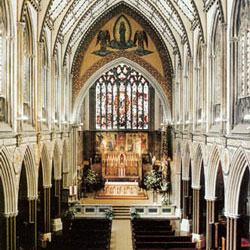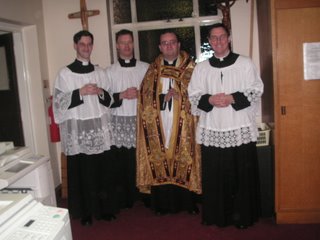Catholic London
Yesterday was a busy day that took me to two of London's most beautiful and interesting churches.


After a stint at the diocesan archives I then made my way to Mayfair and the stunning Jesuit church of the Immaculate Conception, Farm Street, which was opened in 1849 (just before the Restoration of our Hierarchy). The occasion was a Council meeting of the Catholic Records Society - and I urge all readers with an interest in English Catholic history to join. For a very reasonable subscription you get two issues of an internationally respected journal (Recusant History) and a hardback monograph.  There was time, also, to pop into the book launch of the latest offering from Family Publications: a reprint of John Gerard: The Autobiography of an Elizabethan, with a new introduction by Michael Hodgetts. It's a gripping story - as the write up says,
There was time, also, to pop into the book launch of the latest offering from Family Publications: a reprint of John Gerard: The Autobiography of an Elizabethan, with a new introduction by Michael Hodgetts. It's a gripping story - as the write up says,
 And the evening finished with a jolly meal on Newington Green. A great Catholic London day!
And the evening finished with a jolly meal on Newington Green. A great Catholic London day!

First of all I went to St Etheldreda's, Ely Place - a Rosminian church that was founded from my current parish (Kingsland). It is one of the oldest Catholic churches in this country for the chapel dates from the late thirteenth century and was used by the bishops of Ely as their London base. This connection ended at the Reformation but it returned to Catholic hands briefly in the seventeenth century, when it was used by the Spanish Ambassador, and again in 1873, when Fr William Lockhart purchased the property for the Institute of Charity. American readers might be interested to know that the Catholic chapel at West Point Military Academy is modelled on St Etheldreda's.
I went to this venerable church to meet the archivist of the Rosminians, who is an Englishman and was passing through London on his way to Africa. We retired to Ye Old Mitre Tavern, hidden in a nearby alley and originally dating from Elizabeth I's reign. I'm trying to find out more about my new parish's history and, although the Institute's archive contains a file of documentation (including plans of the original church), one would need to go all the way to the Mother House at Stresa in northern Italy. The archivist has kindly invited me to visit at the end of May - an offer I intend to take up (and this has nothing to do with the fact that the place is on the western shore of Lake Maggiore!).

After a stint at the diocesan archives I then made my way to Mayfair and the stunning Jesuit church of the Immaculate Conception, Farm Street, which was opened in 1849 (just before the Restoration of our Hierarchy). The occasion was a Council meeting of the Catholic Records Society - and I urge all readers with an interest in English Catholic history to join. For a very reasonable subscription you get two issues of an internationally respected journal (Recusant History) and a hardback monograph.
 There was time, also, to pop into the book launch of the latest offering from Family Publications: a reprint of John Gerard: The Autobiography of an Elizabethan, with a new introduction by Michael Hodgetts. It's a gripping story - as the write up says,
There was time, also, to pop into the book launch of the latest offering from Family Publications: a reprint of John Gerard: The Autobiography of an Elizabethan, with a new introduction by Michael Hodgetts. It's a gripping story - as the write up says,John Gerard was a Lancashire man, educated at Oxford and ordained in Rome. After a ministry in East Anglia he was arrested and tortured in the Tower of London but, miraculously, escaped and continued working as a priest for the next eight years, even gaining access to the courts of Elizabeth I and James I. After the Gunpowder Plot, however, he fled to the continent where he wrote this autobiography, which transports the reader into a world of priest-holes, secret Masses and high intrigue. He died in Rome in 1637 without ever seeing England again.Finally I rushed back to Kingsland where I was meeting some priest friends for Vespers and Benediction in preparation for the Feast of the Martyrs of the Venerable English College, Rome (1 December). Here is the scene in the sacristy afterwards:
 And the evening finished with a jolly meal on Newington Green. A great Catholic London day!
And the evening finished with a jolly meal on Newington Green. A great Catholic London day!


4 Comments:
Thanks, Father, especially for the picture from 'St. Etheldreda! As a very young boy I read the conversion story of former Communist Douglas Hyde where this church plays a decisive role as instrument of grace (if I remember correctly). So it lingered in the background of my imagination until now where you brought it to life and color.
John Gerard's autobio rings another bell as I just finished Alice Hogge's book on God's Secret Agents. They were a great bunch, all of them English Martyrs! Deo gratias!
I like the sound of the Ye Old Mitre taveren - do you recommend a visit?
I read John Gerard's autobiography during the summer and can definately recommend it. How blessed we are not to be living in those dangerous times.
What's "Rosminian"? Is it like a secret society? Can I get a membership card?
'Rosminian' is the popular name given to the Institute of Charity, a congregation of priests founded by Antonio Rosmini and approved by the Holy See in 1838. Not to be confused with the Rosicrucians!
Post a Comment
<< Home